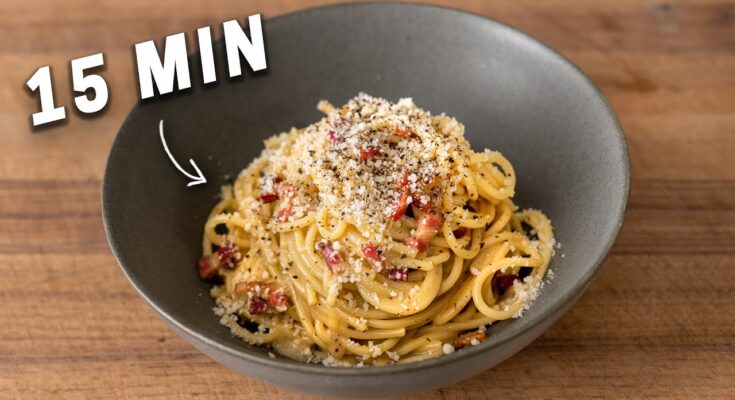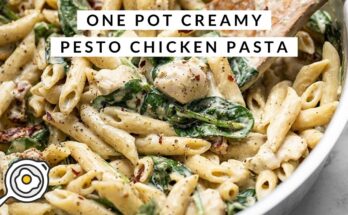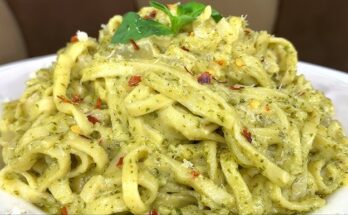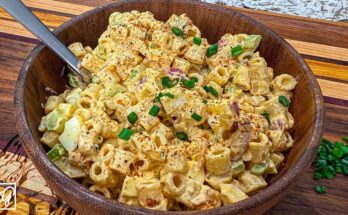Pasta Carbonara Recipe: Pasta Carbonara is one of the most beloved Italian dishes worldwide. With its creamy, velvety sauce, crispy pancetta, and perfectly cooked pasta, this recipe is a comfort food that never fails to impress.
The dish originates from Rome, and its simplicity highlights the use of high-quality ingredients and precise techniques. Whether you’re a seasoned chef or a kitchen newbie, mastering Carbonara will elevate your culinary skills.
Let’s dive into this step-by-step guide to creating the perfect Pasta Carbonara.
Ingredients Needed for Pasta Carbonara
Core Ingredients List
To make authentic Pasta Carbonara, you’ll need:
- Pasta: Spaghetti, bucatini, or rigatoni
- Eggs: 2 large eggs and 2 additional yolks
- Cheese: 1 cup of finely grated Pecorino Romano or Parmesan
- Pancetta or Guanciale: 150 grams, diced
- Black Pepper: Freshly cracked
- Salt: For boiling pasta water
Optional Ingredients for a Twist
- Cream: Although not traditional, some prefer a touch of cream.
- Garlic: To infuse extra flavor into the pancetta.
- Parsley: For garnishing the final dish.
Tips for Sourcing Fresh and Authentic Ingredients
- Look for authentic Pecorino Romano from Italian grocery stores.
- Use fresh, pasture-raised eggs for the best flavor.
- If pancetta or guanciale is unavailable, high-quality bacon is a good substitute.
Equipment You’ll Need
Basic Kitchen Tools Required
- Large pot for boiling pasta
- Medium skillet or frying pan
- Mixing bowl
- Whisk or fork
- Tongs for mixing pasta and sauce
Importance of Using the Right Pan
A non-stick skillet works best for cooking pancetta and mixing the pasta and sauce.
How to Prep Your Kitchen for the Recipe
- Keep all ingredients measured and prepped before starting.
- Have a clean work area to make the process smooth and enjoyable.
Preparing the Ingredients
Measuring the Ingredients Accurately
Carbonara is all about balance. Use a kitchen scale for precise measurements, especially for the cheese and pancetta.
Tips for Grating Cheese Properly
Finely grate the cheese so it melts smoothly into the sauce. A microplane grater works wonders.
How to Handle Eggs Safely
- Crack the eggs into a separate bowl to ensure no shells sneak in.
- Beat the eggs with the grated cheese until fully combined for a smooth base.
The Perfect Pasta
Choosing the Right Type of Pasta
Spaghetti is the classic choice, but feel free to experiment with rigatoni or bucatini for different textures.
How to Cook Pasta Al Dente
- Bring a large pot of salted water to a rolling boil.
- Add the pasta and stir occasionally to prevent sticking.
- Cook 1-2 minutes less than the package instructions for a perfect al dente texture.
Common Pasta-Cooking Mistakes to Avoid
- Don’t add oil to the pasta water; it prevents the sauce from sticking.
- Avoid rinsing the pasta after cooking—it strips away the starch that helps the sauce adhere.
Making the Sauce
How to Achieve a Creamy Consistency
The secret lies in mixing the hot pasta water with the egg mixture to gently cook the eggs without scrambling them.
- Reserve at least 1 cup of pasta water before draining.
- Add it slowly to the egg and cheese mixture while whisking continuously.
Avoiding Common Mistakes in Mixing
- Don’t add the egg mixture directly to the hot pan; it will scramble.
- Ensure the pasta is still hot when mixing so it cooks the eggs just enough.
Temperature Control for the Sauce
Keep the heat low or off entirely when combining the pasta and sauce. Residual heat does the job perfectly.
Combining the Pasta and Sauce
The Importance of Timing
Timing is everything in Carbonara. Once the pasta is cooked, it must be drained and immediately combined with the sauce while still hot. This ensures that the egg mixture thickens into a creamy sauce instead of becoming scrambled eggs.
Mixing Techniques for a Flawless Dish
- Transfer the hot, drained pasta to the pan with the pancetta or guanciale.
- Remove the pan from heat to avoid overheating the eggs.
- Gradually pour the egg and cheese mixture over the pasta while stirring continuously with tongs or a large fork. This allows the sauce to coat each strand evenly.
How to Avoid Overcooking the Eggs
- Work quickly but carefully, ensuring the pasta’s residual heat does the cooking.
- If the sauce begins to clump or scramble, add a bit more reserved pasta water to loosen it.
The Role of Pancetta (or Guanciale)
Choosing Between Pancetta and Guanciale
Guanciale, made from pork cheek, is the traditional choice for Carbonara, offering a richer, deeper flavor. Pancetta, cured pork belly, is easier to find and works beautifully as an alternative.
How to Cook It to Crispy Perfection
- Heat a skillet over medium heat and add the diced guanciale or pancetta.
- Cook slowly, rendering out the fat and stirring occasionally, until the meat is golden and crispy.
- Remove from heat and leave the fat in the pan for added flavor when mixing the pasta.
Substitutions for Vegetarians
For a vegetarian option, replace pancetta with sautéed mushrooms or sun-dried tomatoes. While it changes the dish’s profile, it retains a smoky, savory flavor.
Adding the Finishing Touches
The Importance of Freshly Cracked Black Pepper
Carbonara wouldn’t be complete without a generous sprinkling of freshly cracked black pepper. Its bold, spicy aroma complements the creamy sauce perfectly. Use a pepper mill to achieve a coarse grind for optimal flavor.
Garnishing with Parsley and Extra Cheese
While not traditional, fresh parsley adds a touch of color and freshness to the dish. Sprinkle extra Pecorino Romano or Parmesan on top for an indulgent finish.
Optional Toppings to Elevate the Dish
- Truffle oil or shavings for a luxurious touch
- A soft-poached egg for added richness
- Crumbled crispy bacon or even crushed red pepper flakes for spice lovers
Serving Pasta Carbonara
The Best Way to Plate the Dish
Serve Carbonara immediately after cooking for the best texture and flavor. Use tongs to twirl individual portions onto plates, creating a restaurant-style presentation.
Suggested Side Dishes and Pairings
- A fresh green salad with a light vinaigrette to balance the richness
- Garlic bread or bruschetta for a crunchy side
- A glass of crisp white wine, such as Pinot Grigio, for a classic pairing
How to Store Leftovers Properly
Carbonara is best enjoyed fresh, but if you have leftovers:
- Store in an airtight container in the refrigerator for up to 2 days.
- Reheat gently in a skillet over low heat with a splash of water or milk to revive the sauce.
Common Mistakes to Avoid
Why the Sauce Sometimes Curdles
- Adding the egg mixture to a pan that’s too hot is a common mistake.
- Ensure the heat is off when combining the sauce to maintain a creamy texture.
Overcooking the Pasta or Sauce
- Overcooked pasta turns mushy and doesn’t hold the sauce well.
- Stir continuously to prevent the sauce from clumping or overheating.
Using Heavy Cream vs. the Traditional Method
While heavy cream can create a rich sauce, traditional Carbonara relies solely on eggs and cheese for its creamy texture. Stick to the classic method for authentic results.
Tips for Perfecting Your Carbonara
Secrets for Enhancing Flavor
- Use pasta water liberally; its starchiness binds the sauce and pasta together.
- Opt for high-quality cheeses and meats to elevate the dish’s flavor profile.
Regional Variations in Carbonara Recipes
- In some parts of Italy, people add garlic or onions to the pancetta.
- Northern Italian recipes may include butter for an extra creamy texture.
How to Practice and Perfect the Dish
The key to mastering Carbonara is repetition. With practice, you’ll develop a feel for the right timing, texture, and technique, ensuring flawless results every time.
Nutritional Information
Calories and Macronutrient Breakdown
A traditional serving of Carbonara contains approximately:
- Calories: 500–600
- Protein: 20–25 grams
- Carbohydrates: 40–50 grams
- Fat: 25–30 grams
Adjusting the Recipe for Dietary Needs
- Use gluten-free pasta for those with gluten sensitivity.
- Swap Pecorino Romano for a lower-fat cheese to reduce calories.
Making a Lighter Version of Carbonara
- Use only egg whites instead of whole eggs for the sauce.
- Replace pancetta with turkey bacon or omit it entirely.
Variations of Carbonara
Vegetarian and Vegan Versions
- For a vegetarian version, replace pancetta with roasted vegetables or tofu.
- Vegan Carbonara can be made with plant-based cream, nutritional yeast, and vegan bacon substitutes.
Carbonara with Chicken or Seafood
- Add grilled chicken strips for a protein-packed variation.
- Shrimp or scallops can offer a delightful seafood twist.
Creative Twists from Chefs Worldwide
- Some chefs incorporate ingredients like smoked paprika or lemon zest for added flavor.
- Fusion recipes include Asian-inspired Carbonara with soy sauce or miso paste.
FAQs about Pasta Carbonara Recipe
1. What ingredients do I need for a classic Pasta Carbonara?
For a traditional Pasta Carbonara, you will need spaghetti, fresh eggs, Pecorino Romano cheese, pancetta or guanciale (Italian cured meat), black pepper, and salt. Avoid using cream or milk, as these are not authentic ingredients for this dish.
2. Can I use bacon instead of pancetta?
Yes, while pancetta or guanciale is traditional, bacon is a commonly used substitute. Bacon will give your Carbonara a smokier flavor compared to the more subtle taste of pancetta.
3. How do I prevent the eggs from scrambling?
To avoid scrambling, combine the eggs and cheese in a bowl to create your sauce. After draining your cooked pasta, add it back to the pot with the heat turned off. Quickly mix in the egg and cheese mixture, using the residual heat to cook the eggs gently without scrambling them.
4. Is Pasta Carbonara safe to eat with raw eggs?
Yes, the eggs in Pasta Carbonara are typically safe to eat because they are cooked slightly by the heat of the pasta. However, it’s crucial to use fresh, high-quality eggs and handle them properly.
5. What pasta shapes work best with Carbonara?
Spaghetti is the classic choice for Carbonara. However, other long pasta shapes like linguine or fettuccine can also be used effectively.
6. Can I add garlic or onion to my Carbonara?
Traditional Carbonara does not include garlic or onions, but some variations do. If you prefer these flavors, feel free to add them, keeping in mind that it won’t be the classic version.
7. What’s the best way to serve Pasta Carbonara?
Pasta Carbonara is best served immediately after cooking. It’s meant to be eaten fresh and hot, with an extra sprinkle of freshly grated Pecorino Romano cheese and a dash of freshly ground black pepper.
Conclusion
Pasta Carbonara is a timeless recipe that beautifully combines simplicity and indulgence. Its creamy sauce, savory pancetta, and perfectly cooked pasta make it a dish worth mastering. Whether you stick to the traditional method or experiment with creative variations, Carbonara will always be a crowd-pleaser. So grab your ingredients, follow this guide, and treat yourself to a comforting plate of Pasta Carbonara.



